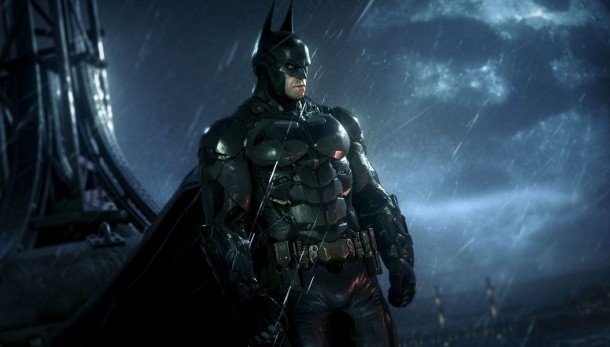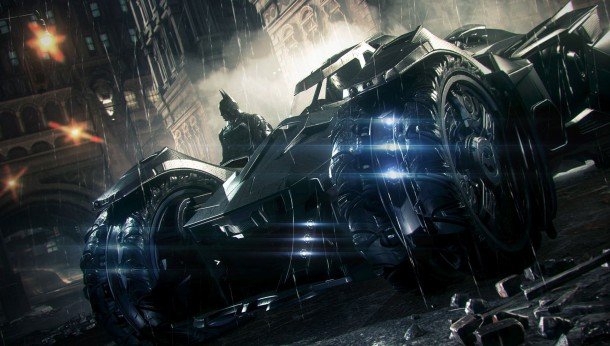Batman: Arkham Knight interview - on story, combat and "civil war on the streets of Gotham"

Batman: Arkham Knight is set in an even larger version of Gotham City than its predecessors managed. It's so big, they've had to include the Batmobile so you can get around quicker. How else are Rocksteady leveraging the muscle of modern PCs? Will we face another rogues' gallery, a la Arkham City? How will the combat system change from the first games? I sat down with Rocksteady's marketing producer Dax Ginn to find out.
PC Gamer: You're dealing with an open world many times the size of your previous games. How did Rocksteady have to adapt to making a world of this size?
Dax Ginn: For us in the past it's been one way or the other. The detail we put into creating Arkham Asylum was critical to the atmosphere of that game. Then in Arkham City when we just blew the doors off and went open world, it was really a balance of how big we could go and how detailed we could execute [the world]. Using the horsepower of next-gen, we've really been able to deliver on both for the first time, and that's just been incredibly awesome for our engine team to be able to say to our art guys and our creative guys, 'you just go for it. Create the atmosphere of Gotham you've always wanted to create.' So the decision to make the game exclusively for next-gen has really opened the door on that for us.
PC Gamer: What were your points of inspiration from Batman lore for the storyline here?
Dax Ginn: It's the craziest thing, because we sort of inspire ourselves. I know that sort of sounds cheesy, but the development and narrative threads set up by the previous games really put us on a path. That's what we knew we had to execute on when it came to Arkham Knight. We were finishing a trilogy so it had to be grounded in the story we told before. It was the same thing with the design of the Batmobile—the Arkham Asylum Batmobile is the foundation for the design of the Arkham Knight Batmobile. It wasn't driveable in Arkham Asylum and it now is this time around. So all the sources of inspiration come from the work we've done before in a very conscious way. Subconsciously, I'm sure we're all insane Batman fans, so who knows where that comes from.
PC Gamer: I felt like I saw a reference and wanted to run it past you - in Barbara Gordon's apartment, did I see a mask from Court Of The Owls?
Dax Ginn: There may have been! We always fill out these things that only 1% of people are going to pick up on, but those people who do, it really means a lot to them, and that's the sort of people we are, so all of our games are full of stuff like that.
Keep up to date with the most important stories and the best deals, as picked by the PC Gamer team.

PC Gamer: You already go into this game with a balanced combat system that I and many other gamers understand the language of very well—how do you change a system like that?
Dax Ginn: It is a fine balance, and we start with 'what are the thugs doing? What is the threat that the combat system needs to meet?' We always want threat that Batman is facing to feel like it's always in escalation. Arkham Asylum was very much a one-on-one challenge with the Joker, Arkham City was much more about chaos and carnage in the city streets. This is all out civil war on the streets of Gotham City, so the threat Batman faces when he comes up against gangs of thugs or the Rogue's Gallery teamed up under Scarecrow means the combat system has to step up to face that threat, so that's the design process we go to. But the connection between Batman's combat system and Batman's gadgetry is something we always try and push, so we've got a new philosophy in Arkham Knight, which is gadgets while gliding. You can glide into a fight throwing batarangs while delivering the first two or three blows, then you go straight into freeflow combat, so that's the way we think about supercharging the combat experience.
PC Gamer: Will players go into Arkham Knight with same inventory they had at the end of Arkham City?
Dax Ginn: Well that continuity is important to us from a gadgetry perspective, so yeah, I think the combat from that perspective is going to feel really familiar to people who finished Arkham City. There's always ways in which we balance and upgrade gadgets, so in the twelve months between the end of Arkham City and the start of Arkham Knight, Batman and the guys in R&D at Wayne Enterprise have been building up the contents of Batman's utility belt so there is a difference, but there's definitely going to be continuity there that's visible.
PC Gamer: There were obviously some hanging threads in Arkham City—Hush, for example, was left unresolved. Can you talk about Hush specifically and continuing those storylines?
Dax Ginn: That's something we do a lot of in our games to really engage players to think about where the story's going to go next. We drop a lot of Easter Eggs, and there was a big Scarecrow Easter Egg at the end of Arkham City as well that gamers will have been able to access, so I'm not going to spoil anything but there are definitely connections. Just like with Asylum and City.

PC Gamer: How central is the Barbara Gordon/Jim Gordon/Batman dynamic to the overall storyline?
Dax Ginn: It's significant. The opportunity to really focus on Batman's emotional state and what drives Batman as a man, not as a hero, and we've never done that before. And Oracle has only ever been a voice in Batman's ear. To physically bring her into the game and use her as a character to help us analyse and understand how Batman's feeling from an emotional perspective is really exciting. And then the connection with Jim Gordon, there's a lot of history there, then there's the history between father and daughter. This is our largest game but it's also our most emotional.
PC Gamer: How are you structuring the sidequests in Arkham Knight compared to City? I liked that in City, these mini-sagas ran concurrently with the main storyline as opposed to the player feeling the need to tick them off of a list. Is it the same sort of structure?
Dax Ginn: We've done more of that. I think that worked really well in Arkham City as well, but we had a clear distinction between what's the main path and what are the side quests. In Arkham Knight it's much more about the city being occupied by the different supervillains working to Scarecrow's agenda. So he's unified all of the Rogue's Gallery against Batman to destroy Batman, but the experience of moving through the game is very much you picking the fights you want to pick and following those through in any way that you want, so it's a much more organic way of moving through the game.
PC Gamer: Thanks for your time.
For more on Arkham Knight, check out our first-look preview .


